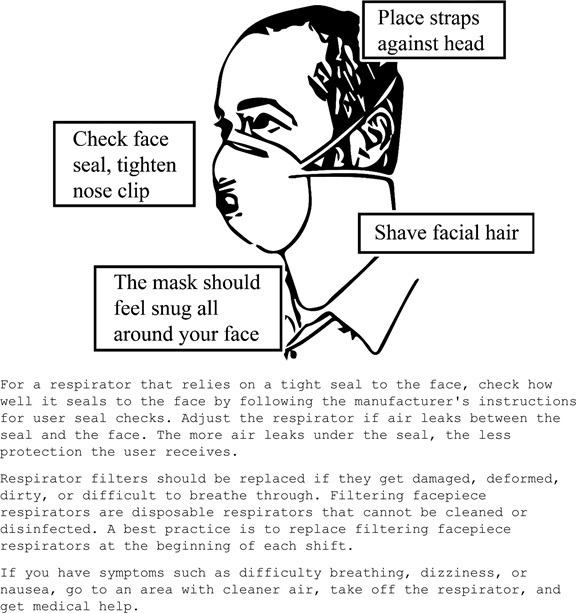Respirators can be an effective way to protect employee health by reducing exposure to wildfire smoke, when they are properly selected and worn.
When PM2.5 concentrations are below 555 ug/m3, N95 masks will be available for use by employees working outdoors. These are often commonly referred to as “dust masks” or “painter’s masks.” Surgical masks, bandannas, cloth masks, and KN95 masks (a Chinese version of the N95) will not be acceptable for use.
N95 masks will be provided with the following caveats:
- Read and follow the manufacturer’s instructions on the respirator’s use, maintenance, cleaning and care, along with any warnings regarding the respirator’s limitations. The manufacturer’s instructions for medical evaluations, fit testing, and shaving should also be followed to ensure the best protection against wildfire smoke.
- These respirators shall not be worn in areas where the air contains contaminants for which the respirator is not designed. A respirator designed to filter particles will not protect you against gases or vapors, and it will not supply oxygen.
- You should keep track of your respirator so you do not mistakenly use someone else’s respirator.
- Particularly if you have a heart or lung problem, or if you have other medical problems and have questions about whether it is safe for you to wear a respirator, you should talk to your doctor before wearing one. If you have concerns about your ability to safely wear a respirator, please discuss an alternate accommodation with your supervisor and/or WSU Human Resource Services.
How to properly put on, use, and maintain the respirators provided by the employer.
To get the most protection from a respirator, there must be a tight seal around the face. A respirator will provide much less protection if facial hair interferes with the seal.
The proper way to put on a respirator depends on the type and model of the respirator.
For those who use an N95 or other filtering facepiece respirator that is made of filter material:
- Place the mask over the nose and under the chin, with one strap placed below the ears and one strap above.
- Pinch the metal part (if there is one) of the respirator over the top of the nose so it fits securely.
- Perform a seal check:
- Cover the respirator with both hands and exhale. If air leaks where the respirator seals against the face, adjust the respirator and nosepiece and try again. When a proper fit is achieved, the respirator should bulge from the face and not leak around the seal.
- Cover the respirator with both hands and inhale. If air leaks where the respirator seals against the face, adjust the respirator and nosepiece and try again. When a proper fit is achieved, the respirator should collapse slightly and not leak around the seal.

Other Respirators
There are other types of respirators that are available, such as:
- Loose-fitting powered air purifying respirator; or
- Full-facepiece air purifying respirator; or
- Full-facepiece powered air purifying respirator
These respirators are more protective than N95s. However, these require additional training as well as annual fit testing, and a medical evaluation. For some of these, you must be clean shaven to wear them use.
These types of respirators are not required until PM2.5 concentrations reach 555 ug/m3. In most cases, it will be impractical for employees to wear these while performing duties outside. Based on this and the additional requirements for their use, to the extent possible outdoor work will be curtailed rather than providing respirators for all employees.





